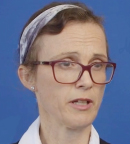Two phase III trials provide support for secondary cytoreductive surgery in women with recurrent ovarian cancer, with the caveats that patient selection is key and the surgery should be performed at sites of excellence. The results of the DESKTOP III and SOC1 trials, both presented during the ASCO20 Virtual Scientific Program, found cytoreductive surgery improved outcomes in selected patients.1,2
DESKTOP III is the first randomized phase III trial to demonstrate an improvement in survival with secondary surgery for recurrent ovarian cancer. In this study, secondary surgery prior to second-line chemotherapy extended median overall survival from 46 months with second-line chemotherapy and no surgery to 53.7 months (P = .02).1 However, the benefit of secondary surgery was observed only in cases where a complete resection was achieved.
The phase III SOC1 trial, conducted in a slightly younger population, found that secondary cytoreductive surgery improved progression-free survival at first relapse vs chemotherapy alone (17.4 months vs 11.9 months, respectively, a 5.5-month absolute improvement and a 42% improvement in progression-free survival, P < .001), but again, the benefit was restricted to patients with no residual disease after surgery.2
The role of secondary surgical cytoreduction in women with recurrent ovarian cancer has been debated for some time, leading to five global phase III trials with generally similar designs to resolve this issue. Although both the DESKTOP III and the SOC1 trials support the role of secondary surgery, with the previously mentioned caveats, a third trial, GOG-0213, published in 2019, did not show an overall survival benefit.3

Helen MacKay, MD
Helen MacKay, MD, Professor at the University of Toronto and Head of the Division of Medical Oncology and Hematology at Sunnybrook Odette Cancer Centre, Toronto, was enthusiastic about the results of both of these trials at a Gynecological Cancer Highlights session during the ASCO meeting. “We have randomized data for the first time, moving the all-important bar of overall survival. These studies provide real hope for the future to achieve our goal of getting patients to live longer and better,” she stated.
DESKTOP III
The phase III DESKTOP III trial enrolled 407 women with recurrent ovarian cancer in first relapse between 2010 and 2014 at 80 centers in 12 countries. Women were randomly assigned to receive chemotherapy alone or surgery followed by chemotherapy; 90% received the suggested platinum-containing regimen.
Special criteria for secondary surgery, developed and validated by the German Gynecological Oncology Group (AGO), were used to select patients for the trial: a good performance status, complete resection at first cytoreductive surgery, and no ascites or small-volume ascites (< 500 mL). To be enrolled in the trial, patients had to have a platinum-free interval of at least 6 months; the median platinum-free interval was 19.9 months. The primary endpoint was overall survival.
“Surgeons were selected for the trial based on prior performance,” said lead author Andreas du Bois, MD, PhD, Professor of Gynecologic Oncology at Kliniken Essen-Mitte, Essen, Germany. “The overall survival benefit was highest and exclusively seen in women with complete resection, indicating the importance of thorough selection of both the right patient and the right [surgical] center.”

Andreas du Bois, MD, PhD
At baseline, demographic and disease characteristics were well balanced between the two arms. The median age was about 62, about 75% had stage III or IV disease, and more than 80% had grade 2 or 3 histology. Less than 5% received a poly (ADP-ribose) polymerase (PARP) inhibitor, and about 25% received bevacizumab. “PARP inhibitors and bevacizumab were not so popular when the study was designed,” Dr. du Bois noted.
In the surgery-alone arm, overall survival in patients who achieved complete resection with secondary surgery was a median of 61.9 months vs 28.8 months for those with residual disease after surgery (P < .001). Comparing complete resection and no surgery, median overall survival was 61.9 months vs 46 months—a 15.9-month difference. “This underlines the importance of complete resection,” commented Dr. du Bois.
“Remember, 50% of patients with a platinum-free interval of more than 6 months will have a positive AGO score, and 75% will end up with a complete resection of visible disease. The median survival gain in this group of patients is more than 12 months if they achieve a complete resection, and this is worth going for,” he stated.
In the surgery-alone arm, 187 of 206 patients (91%) were able to undergo secondary surgery. Surgery also improved progression-free survival from 14 months with chemotherapy to 18.4 months with surgery followed by chemotherapy (P < .001).
No deaths were reported in the surgery-alone arm within the first 30 days, and one death occurred within 90 days. Of the control arm, 11% subsequently went on to cytoreductive surgery.
SOC1 Trial
Although secondary cytoreductive surgery is controversial in the United States, it is standard of care for recurrent ovarian cancer in China. “Secondary cytoreductive surgery in selected patients resulted in a dramatically significant extension of progression-free survival at a median follow-up of 36 months,” said Rong-Yu Zang, MD, PhD, of the Division of Gynecologic Oncology, Zhongshan Hospital, Shanghai. “The interim analysis of accumulated treatment-free survival indicates secondary cytoreductive surgery might contribute to long-term survival.”
The interim analysis of accumulated treatment-free survival indicates secondary cytoreductive surgery might contribute to long-term survival.”— Rong-Yu Zang, MD, PhD
Tweet this quote
SOC1 randomly assigned 356 women with recurrent ovarian cancer in first relapse to receive secondary cytoreductive surgery plus chemotherapy (docetaxel/carboplatin) or chemotherapy alone. Eligibility criteria differed from those of DESKTOP III—a platinum-free interval of at least 6 months and an integrative model score < 4.7. (The integrated model is a validated scoring algorithm that shows prognostic value of secondary cytoreductive surgery.)
The median age of patients was 54. More than 80% had stage III or IV disease. The median platinum-free interval at baseline was 16.1 months. The primary endpoint is progression-free survival, with a hierarchical assessment of overall survival if the progression-free survival endpoint was successfully reached.
The rate of complete resection was 76.7%. Patients with no residual disease after surgery had a median progression-free survival of 19.1 months vs 12.6 months for those with residual disease (comparable to 11.9 months in the chemotherapy arm). Median overall survival results were immature. The 3-year overall survival rate was 68% vs 66%, respectively.
KEY POINTS
- Lessons learned from the DESKTOP III and SOC1 phase III trials include the importance of validated criteria for patient selection and the experience of surgeons in improving outcomes for women who undergo secondary cytoreductive surgery for recurring platinum-sensitive ovarian cancer.
- DESKTOP III showed extended survival in women who achieved complete resection.
- SOC1 showed prolonged progression-free survival in those who achieved complete resection. Survival data are still immature.
Additional Commentary
“In SOC1, surgery at best did not improve outcomes over chemotherapy alone and at worst may have been detrimental,” Dr. MacKay commented. “The study showed that women who cannot experience complete resection may not reap benefits.”
Dr. MacKay continued: “Both studies have implications for clinical practice. We now have randomized evidence showing a benefit for surgery in women with recurrent platinum-sensitive disease who are carefully selected for the probability of undergoing potentially complete resection. However, the surgical debate is not over. Further optimization can be achieved by better patient selection.”
DISCLOSURE: Dr. MacKay has served as a consultant to AstraZeneca and has received research funding from Eisai and Merck. Dr. du Bois has financial relationship with AstraZeneca, BioCad, Clovis Oncology, Doxolipad, Genmab, Ingress Health, Roche/Genentech, and Tesaro. Dr. Zang reported no conflicts of interest.
REFERENCES
1. du Bois A, Sehouli J, Vergote I, et al: Randomized phase III study to evaluate the impact of secondary cytoreductive surgery in recurrent ovarian cancer: Final analysis of AGO DESKTOP III/ENGOT-ov20. ASCO20 Virtual Scientific Program. Abstract 6000.
2. Zang R, Zhu J, Shi T, et al: A randomized phase III trial of secondary cytoreductive surgery in later recurrent ovarian cancer: SOC1/SGOG-OV2. ASCO20 Virtual Scientific Program. Abstract 6001.
3. Coleman RL, Spirtos NM, Enserro D, et al: Secondary surgical cytoreduction for recurrent ovarian cancer. N Engl J Med 381:1929-1939, 2019.

